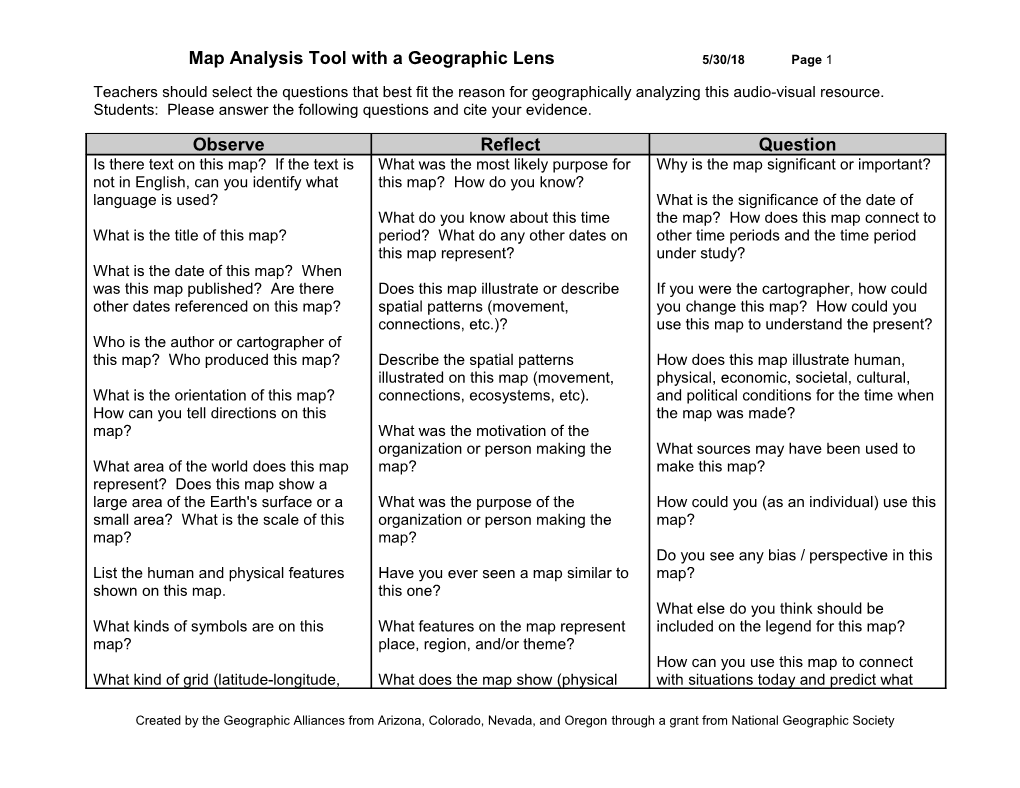Map Analysis Tool with a Geographic Lens 5/27/15 Page 2
Observe / Reflect / QuestionIs there text on this map? If the text is not in English, can you identify what language is used?
What is the title of this map?
What is the date of this map? When was this map published? Are there other dates referenced on this map?
Who is the author or cartographer of this map? Who produced this map?
What is the orientation of this map? How can you tell directions on this map?
What area of the world does this map represent? Does this map show a large area of the Earth's surface or a small area? What is the scale of this map?
List the human and physical features shown on this map.
What kinds of symbols are on this map?
What kind of grid (latitude-longitude, alphanumeric) does the map use?
What kinds of labels are on this map?
What colors are on the map?
Is there a legend on the map?
Is an inset map present? / What was the most likely purpose for this map? How do you know?
What do you know about this time period? What do any other dates on this map represent?
Does this map illustrate or describe spatial patterns (movement, connections, etc.)?
Describe the spatial patterns illustrated on this map (movement, connections, ecosystems, etc).
What was the motivation of the organization or person making the map?
What was the purpose of the organization or person making the map?
Have you ever seen a map similar to this one?
What features on the map represent place, region, and/or theme?
What does the map show (physical characteristics, human patterns)?
How does this map represent and/or illustrate geographic themes (places, regions, human-environment interaction, movement, physical systems, etc.)?
What is the bias or point of view of this map?
How does this map compare to current maps of this place? How does this map prepare people today to deal with issues today?
What other information can you infer from the map?
Why would an inset map be included on this map? / Why is the map significant or important?
What is the significance of the date of the map? How does this map connect to other time periods and the time period under study?
If you were the cartographer, how could you change this map? How could you use this map to understand the present?
How does this map illustrate human, physical, economic, societal, cultural, and political conditions for the time when the map was made?
What sources may have been used to make this map?
How could you (as an individual) use this map?
Do you see any bias / perspective in this map?
What else do you think should be included on the legend for this map?
How can you use this map to connect with situations today and predict what might happen in the future?
How does this map connect to other primary, secondary, or tertiary resources?
What else did you observe about the map? What questions do you have about this map? What other information do you need to make sense of this map?
About what does this map leave you curious?
What seems to be missing from the map?
Teacher Notes for Using this Tool to Develop Geographic Thinking while Engaging Primary Sources
While this tool encompasses many aspects for analyzing primary sources through a geographic lens, the creators do not intend to limit its usage by teachers; however, these are some suggestions:
1. It is understood that the use of this tool may seem overwhelming to a student.
2. Teachers may select 3-5 questions from each column that would best fit the purpose for using the chosen primary source.
3. The teacher should create a separate assignment sheet for the students.
4. The teacher can manipulate these questions into any format (graphic organizer, worksheet, PowerPoint, etc.). It is suggested that the questions be kept intact as to the three general categories since these mirror the headings: Observe, Reflect, and Question.
5. Some vocabulary development may need to occur to use this tool effectively. Close reading strategies applied before using this tool will greatly increase student achievement.
6. This tool can serve as formative or summative assessment.
7. Please think of this tool as a skeleton on which to hang additional materials or resources that the teacher or student may discover.
